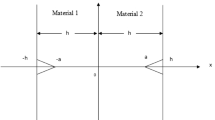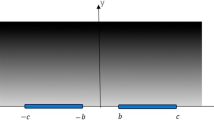Abstract
We consider a homogeneous elastic, orthotropic solid containing three equal collinear cracks, loaded in tension by symmetrically distributed normal stresses. Following Guz’s representation theorem and solving Riemann–Hilbert problems we determine the expressions of the complex potentials. Using the asymptotic analysis, we obtain the asymptotic values of the incremental stress and displacement fields. We determine the tangential stresses near the crack tips. Using the maximum tangential stress criterion and numerical computations we study the interaction problem for a Graphite-epoxy fiber reinforced composite material.






Similar content being viewed by others
References
Guz AN (1999) Fundamentals of the three dimensional theory of stability of deformable bodies. Springer, Berlin
Cristescu ND, Craciun EM, Soos E (2003) Mechanics of elastic composites. CRC Press, Boca Raton
Craciun EM, Soos E (1998) Interaction of two unequal cracks in a prestressed fiber reinforced elastic composite. Int J Fract 94:137–159
Muskhelishvili NI (1953) Some basic problems of the mathematical theory of elasticity. Noordhoff Ltd, Groningen
Lekhnitski SG (1963) Theory of elasticity of aniosotropic elastic body. Holden Day, San Francisco
Panasyuk VV (2002) Strength and fracture of solids with cracks. National Academy of Sciences of Ukraine, Lviv
Kachanov LM (1974) Fundamentals of fracture mechanics. Nauka, Moskow (in Russian)
Sih GC, Leibowitz H (1968) Mathematical theories of britle fractures. In: Leibowitz H (ed) Fracture—an advanced treatise, vol II, mathematical fundamentals. Academic Press, New York, pp 68–591
Leblond JB (2003) Mecanique de la Rupture Fragile et Ductile, series Etudes en Mecanique des Materiaux et des Structures, Hermes
Sneddon IN, Lowengrub M (1969) Crack problem in the classical theory of elasticity. Wiley, New Jersey
Soos E (1996) Resonance and stress concentration in a pre-stressed elastic solid containing a crack. An apparent paradox. Int J Eng Sci 34:363–374
Peride N, Carabineanu A, Craciun EM (2009) Mathematical modelling of the interface crack propagation in a pre-stressed fiber reinforced elastic composite. Comput Mater Sci 45(3):684–692
Carabineanu A, Peride N, Rapeanu E, Craciun EM (2009) Mathematical modelling of the interface crack. A new improved numerical method. Comput Mater Sci 46(3):677–681
Craciun EM, Baesu E, Soos E (2005) General solution in terms of complex potentials for incremental antiplane states in prestressed and prepolarized piezoelectric crystals: application to Mode III fracture propagation. IMA J Appl Math 70(1):39–52
Radi E, Bigoni D, Capuani D (2002) Effects of pre-stress on crack field in elastic, incompresible solids. Int J Solids Struct 39:3971–3996
Azhdari A, Obata M, Nemat-Nasser S (2000) Alternative solution methods for cracks problems in plane anisotropic elasticity, with examples. Int J Solids Struct 37:64336478
Valentini M, Serkov SK, Bigoni D, Movchan AB (1999) Crack propagation in a brittle elastic material with defects. J Appl Mech 66:79–86
Bigoni D, Movchan AB (2002) Statics and dynamics of structural interfaces in elasticity. Int J Solids Struct 39:48434865
Petrova V, Tamusz V, Romalis N (2000) A survey of macro-microcrack interaction problems. Appl Mech Rev 53(5):117–146
Sih GC (1973) A special theory of crack propagation, In: Sih GC (ed) Mechanics of fracture, vol I. Norhoof Int. Leyden, pp XXI–XLV
Sneddon IN, Lowengrub M (1969) Crack problems in the classical theory of elasticity. Wiley, New York
Kaminskii AA, Bogdanova OS (1996) Modelling the failure of orthotropic materials subjected to biaxial loading. Int Appl Mech 32(10):813–819
Rose LRF (1986) Microcrack interaction with a main crack. Int J Fract 31:233–242
Sadowski T, Marsavina L, Peride N, Craciun E-M (2009) Cracks propagation and interaction in an orthotropic elastic material: analytical and numerical methods. Comput Mater Sci 46(3):687–693
Dhaliwal RS, Singh BM, Chehil DS (1986) Two coplanar Griffith cracks under shear loading in an infinitely long elastic layer. Eng Fract Mech 23(4):695–704
Tranter CJ (1961) The opening of a pair of coplanar Griffith’s cracks under internal pressure. Q J Mech Appl Mech 13:269–280
Willmore TJ (1969) The distribution of stress in the neighborhood of a crack. Q J Mech Appl Math 53–60
Bogdanova OS (2007) Limiting state of an elastoplastic orthotropic plate with a periodic system of collinear cracks. Int Appl Mech 43(5):539–546
Kachanov M (1985) A simple technique of stress analysis in elastic solids with many cracks. Int J Fract 28:R11–R19
Aggarwala BD (1998) Three collinear cracks in plane elasticity and related problem. Z Angew Math Mech 78(12):855–860
Mukherjee S, Das S (2007) Interaction of three interfacial Griffith cracks between bounded dissimilar orthotropic half planes. Int J Solids Struct 44:5437–5446
Dhaliwal RS, Singh BM, Rockne JG (1980) Three coplanar Griffith cracks in an infinite elastic layer under antiplane loading. Rundfunktech Mitt 10:435–459
Dhawan GK, Dhaliwal RS (1978) On three coplanar cracks in a transversely isotropic medium. Int J Eng Sci 16(4):253–262
Tvardovski VV (1990) Further results on rectilinear line cracks and inclusions in anisotropic medium. Theor Appl Fract Mech 13:193–207
Craciun EM, Sadowski T, Rabaea A (2014) Stress concentration in an anisotropic body with three equal collinear cracks in Mode II of fracture. I. Analytical study. Z Angew Math Mech 94(9):721–729
Erdogan F, Sih GC (1963) On the crack extension in plates under plane loading and transverse shear. ASME J Basic Eng 85:519–525
Gdoutos EE (1993) Fracture mechanics. An introduction. Kluwer Academic Publishers, Boston
Acknowledgments
Financial support of Structural Funds in the Operational Programme - Innovative Economy (IE OP) financed from the European Regional Development Fund - Project "Modern material technologies in aerospace industry", No POIG.0101.02-00-015/08 is gratefully acknowledged (RT-15: Unconventional technologies of joining elements of aeronautical constructions). E.M.C. acknowledges financial support from the ERC Advanced Grant ‘Instabilities and nonlocal multiscale modelling of materials’ FP7-PEOPLE-IDEAS-ERC-2013-AdG (2014-2019). Support by Polish Ministry of Science and Education within the statutory research No S/20/2015 is also acknowledged.
Author information
Authors and Affiliations
Corresponding author
Appendix
Appendix
From (2.2) we get that \(\varPhi _j(z_j)\) can be multivalued even if \(\varPsi _j(z_j), j=1,2\) are univalued. Consequently, to assure the uniformity of the displacement fields, we must guarantee the uniformity of the potentials \(\varPhi _j(z_j), j=1,2\) on closed path around the two cracks.
We denote by U and V the crack tips and by \(\varLambda \) and \(\varLambda _j\) the corresponding simple closed curves around the crack (U, V) in the complex planes \(z=x_1+ix_2\) and respectively \(z_j=x_1+\mu _j x_2, j=1,2\).
According to the relations (2.1) and (2.2) the uniformity of \(u_1\) is assured if the potentials \(\varPsi _j(z_j), j=1,2\) satisfy the restriction:
Taking into account that the integrals involved in (5.1) rest unchanged if \(\varLambda \) and \(\varLambda _j, j=1,2\) are changed, and squeezing the curve \(\varLambda \) around the crack we obtain that the restriction (5.1) is equivalent to the following one:
Using the relations (2.27) and (2.28), the uniformity of \(u_1\) will be assured if and only if the following condition is satisfied for all three cracks:
where \(\varGamma _0\) and the polynomial Q(t) [see (2.28) for coefficients] are given by:
Since, the limit values \(\varPsi _1^{-}(t)\) and \(\varPsi _2^{-}(t)\) satisfies the equations
we can conclude that the condition (5.3) is fulfilled for all three cracks.
The uniformity of \(u_2\) is assured if the condition will be satisfied
The above condition is fulfilled if we have satisfied the relations
for all three cracks, or, in the equivalent form:
where we denoted by P(t) the polynomial:
Denoting by
observe that
and
with (2.28) the restrictions (5.10) take the following system of algebraic equations:
Solving the above system, we get the following values for the coefficients \(C_0, C_1\) and \(C_2\) of the polynomial P(z):
Rights and permissions
About this article
Cite this article
Sadowski, T., Craciun, E.M., Răbâea, A. et al. Mathematical modeling of three equal collinear cracks in an orthotropic solid. Meccanica 51, 329–339 (2016). https://doi.org/10.1007/s11012-015-0254-5
Received:
Accepted:
Published:
Issue Date:
DOI: https://doi.org/10.1007/s11012-015-0254-5




